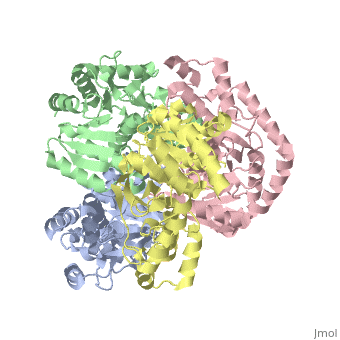|
|
| Line 3: |
Line 3: |
| | <StructureSection load='2v6b' size='340' side='right'caption='[[2v6b]], [[Resolution|resolution]] 2.50Å' scene=''> | | <StructureSection load='2v6b' size='340' side='right'caption='[[2v6b]], [[Resolution|resolution]] 2.50Å' scene=''> |
| | == Structural highlights == | | == Structural highlights == |
| - | <table><tr><td colspan='2'>[[2v6b]] is a 4 chain structure with sequence from [https://en.wikipedia.org/wiki/"micrococcus_radiodurans"_raj_et_al._1960 "micrococcus radiodurans" raj et al. 1960]. Full crystallographic information is available from [http://oca.weizmann.ac.il/oca-bin/ocashort?id=2V6B OCA]. For a <b>guided tour on the structure components</b> use [https://proteopedia.org/fgij/fg.htm?mol=2V6B FirstGlance]. <br> | + | <table><tr><td colspan='2'>[[2v6b]] is a 4 chain structure with sequence from [https://en.wikipedia.org/wiki/Deinococcus_radiodurans Deinococcus radiodurans]. Full crystallographic information is available from [http://oca.weizmann.ac.il/oca-bin/ocashort?id=2V6B OCA]. For a <b>guided tour on the structure components</b> use [https://proteopedia.org/fgij/fg.htm?mol=2V6B FirstGlance]. <br> |
| - | </td></tr><tr id='activity'><td class="sblockLbl"><b>Activity:</b></td><td class="sblockDat"><span class='plainlinks'>[https://en.wikipedia.org/wiki/L-lactate_dehydrogenase L-lactate dehydrogenase], with EC number [https://www.brenda-enzymes.info/php/result_flat.php4?ecno=1.1.1.27 1.1.1.27] </span></td></tr> | + | </td></tr><tr id='method'><td class="sblockLbl"><b>[[Empirical_models|Method:]]</b></td><td class="sblockDat" id="methodDat">X-ray diffraction, [[Resolution|Resolution]] 2.5Å</td></tr> |
| | <tr id='resources'><td class="sblockLbl"><b>Resources:</b></td><td class="sblockDat"><span class='plainlinks'>[https://proteopedia.org/fgij/fg.htm?mol=2v6b FirstGlance], [http://oca.weizmann.ac.il/oca-bin/ocaids?id=2v6b OCA], [https://pdbe.org/2v6b PDBe], [https://www.rcsb.org/pdb/explore.do?structureId=2v6b RCSB], [https://www.ebi.ac.uk/pdbsum/2v6b PDBsum], [https://prosat.h-its.org/prosat/prosatexe?pdbcode=2v6b ProSAT]</span></td></tr> | | <tr id='resources'><td class="sblockLbl"><b>Resources:</b></td><td class="sblockDat"><span class='plainlinks'>[https://proteopedia.org/fgij/fg.htm?mol=2v6b FirstGlance], [http://oca.weizmann.ac.il/oca-bin/ocaids?id=2v6b OCA], [https://pdbe.org/2v6b PDBe], [https://www.rcsb.org/pdb/explore.do?structureId=2v6b RCSB], [https://www.ebi.ac.uk/pdbsum/2v6b PDBsum], [https://prosat.h-its.org/prosat/prosatexe?pdbcode=2v6b ProSAT]</span></td></tr> |
| | </table> | | </table> |
| | + | == Function == |
| | + | [https://www.uniprot.org/uniprot/LDH_DEIRA LDH_DEIRA] |
| | == Evolutionary Conservation == | | == Evolutionary Conservation == |
| | [[Image:Consurf_key_small.gif|200px|right]] | | [[Image:Consurf_key_small.gif|200px|right]] |
| Line 33: |
Line 35: |
| | __TOC__ | | __TOC__ |
| | </StructureSection> | | </StructureSection> |
| - | [[Category: Micrococcus radiodurans raj et al. 1960]] | + | [[Category: Deinococcus radiodurans]] |
| - | [[Category: L-lactate dehydrogenase]]
| + | |
| | [[Category: Large Structures]] | | [[Category: Large Structures]] |
| - | [[Category: Coquelle, N]] | + | [[Category: Coquelle N]] |
| - | [[Category: Fioravanti, E]] | + | [[Category: Fioravanti E]] |
| - | [[Category: Vellieux, F]] | + | [[Category: Vellieux F]] |
| - | [[Category: Weik, M]] | + | [[Category: Weik M]] |
| - | [[Category: Cytoplasm]]
| + | |
| - | [[Category: Glycolysis]]
| + | |
| - | [[Category: Lactate dehydrogenase]]
| + | |
| - | [[Category: Ldh]]
| + | |
| - | [[Category: Mesophilic]]
| + | |
| - | [[Category: Nad]]
| + | |
| - | [[Category: Oxidoreductase]]
| + | |
| - | [[Category: Radioresistance]]
| + | |
| Structural highlights
Function
LDH_DEIRA
Evolutionary Conservation
Check, as determined by ConSurfDB. You may read the explanation of the method and the full data available from ConSurf.
Publication Abstract from PubMed
Lactate dehydrogenase (LDH) catalyzes the conversion of pyruvate to lactate with concomitant oxidation of NADH during the last step in anaerobic glycolysis. In the present study, we present a comparative biochemical and structural analysis of various LDHs adapted to function over a large temperature range. The enzymes were from Champsocephalus gunnari (an Antarctic fish), Deinococcus radiodurans (a mesophilic bacterium) and Thermus thermophilus (a hyperthermophilic bacterium). The thermodynamic activation parameters of these LDHs indicated that temperature adaptation from hot to cold conditions was due to a decrease in the activation enthalpy and an increase in activation entropy. The crystal structures of these LDHs have been solved. Pairwise comparisons at the structural level, between hyperthermophilic versus mesophilic LDHs and mesophilic versus psychrophilic LDHs, have revealed that temperature adaptation is due to a few amino acid substitutions that are localized in critical regions of the enzyme. These substitutions, each having accumulating effects, play a role in either the conformational stability or the local flexibility or in both. Going from hot- to cold-adapted LDHs, the various substitutions have decreased the number of ion pairs, reduced the size of ionic networks, created unfavorable interactions involving charged residues and induced strong local disorder. The analysis of the LDHs adapted to extreme temperatures shed light on how evolutionary processes shift the subtle balance between overall stability and flexibility of an enzyme.
Activity, stability and structural studies of lactate dehydrogenases adapted to extreme thermal environments.,Coquelle N, Fioravanti E, Weik M, Vellieux F, Madern D J Mol Biol. 2007 Nov 23;374(2):547-62. Epub 2007 Sep 22. PMID:17936781[1]
From MEDLINE®/PubMed®, a database of the U.S. National Library of Medicine.
See Also
References
- ↑ Coquelle N, Fioravanti E, Weik M, Vellieux F, Madern D. Activity, stability and structural studies of lactate dehydrogenases adapted to extreme thermal environments. J Mol Biol. 2007 Nov 23;374(2):547-62. Epub 2007 Sep 22. PMID:17936781 doi:http://dx.doi.org/10.1016/j.jmb.2007.09.049
|


